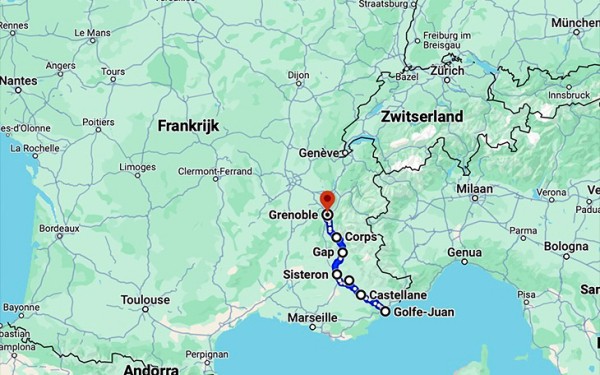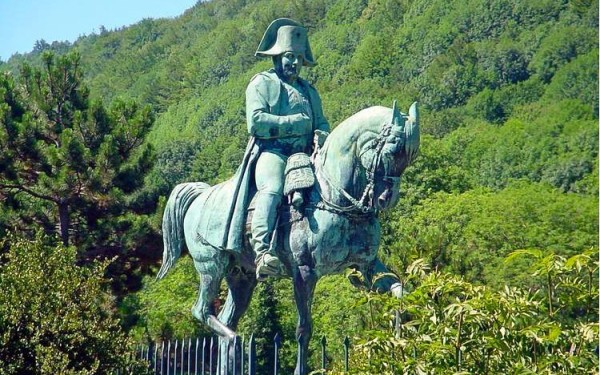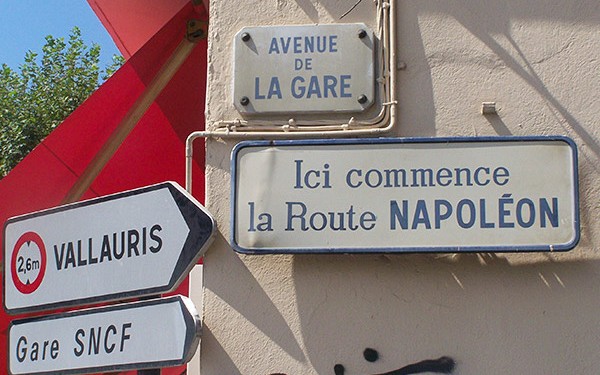The Route Napoléon (N85) is an iconic route of approximately 325 kilometers through Provence between Golfe-Juan on the Côte d'Azur and Grenoble, at the foot of the Alps. During your holiday in the South of France, you can drive part of this road from your holiday home along the Route Napoleon. It is one of the most famous and beautiful car routes in France, which has a lot to offer both historically and landscape-wise. The route follows the path taken by Napoleon Bonaparte in 1815 after his escape from the island of Elba and his famous return to Paris to regain power. Along the Route Napoleon you will find historical sites, impressive nature and charming towns. In the various villages and towns along the Route de Napoleon in southern France, holidays, anniversaries and events are organized every year that commemorate Napoleon Bonaparte's historic journey in 1815.
Drive the Route Napoleon from your holiday home in Provence
Napoleon Bonaparte, Emperor of France
Napoleon Bonaparte became emperor of France in 1804 and ruled over a large part of Europe for many years. However, his power came under pressure after the failed campaign to Russia in 1812 and the defeat at the Battle of the Nations at Leipzig in 1813. A coalition of European powers invaded France and took Paris. In April 1814, Napoleon was forced to abdicate and was exiled to the island of Elba, just off the Italian coast. He was allowed to keep his imperial title and was given the government of Elba, where he implemented various reforms and built up a small army. Despite the surveillance, Napoleon managed to escape after about 300 days. In February 1815 he returned to France with a group of followers. On March 1, 1815, Napoleon came ashore with about 1100 men in Golfe-Juan, near Cannes, where the army that was supposed to stop him, joined him. In a rapid advance, he marched through the Alps to Grenoble, in an attempt to depose King Louis XVIII and restore his empire. When driving in the Alps you will pass FranceComfort holiday parks AlpChalets Portes du Soleil and AlpResort Portes du Soleil. The route he took was officially renamed the Route Napoléon in 1932 and has since been marked with the symbol of the eagle, the emperor's emblem.
To avoid royalist resistance in the Rhône Valley Napoleon chose a route through the mountains via Grasse, Digne and Gap towards Grenoble. Along the route, many places where Napoleon stayed, ate or spent the night are marked with monuments or commemorative plaques. During this journey, his following grew steadily, partly because he met more and more sympathizers along the way. Napoleon took seven days to complete the journey of about 325 kilometres, a route that today follows the N85 and winds through four French departments. After 20 days, he arrived in Paris as a folk hero, marking the beginning of The Hundred Days: the short period in which Napoleon seized power again. He tried to re-establish his position by attacking the Allies, but suffered a decisive defeat at the Provincial Championships on 18 June 1815 at the Battle of Waterloo. After this, he was definitively deposed and imprisoned again. This time, Napoleon was exiled to the remote island Saint Helena in the Atlantic Ocean, more than 1,800 kilometres from the African west coast. The island was chosen because of its isolated location, so escape was virtually impossible. Napoleon died on May 5, 1821 on Saint Helena. In 1840 his remains were transferred to France and he was buried in the Dôme des Invalides in Paris.

Route and highlights Route Napoléon
The Route Napoléon, the most beautiful car route in France according to some, is located between Golfe-Juan on the Côte d'Azur and Grenoble, at the foot of the Alps. Whilst driving on the Route Napoleon, you will pass a number of picturesque cities, impressive nature, and stunning sights. These towns and villages together form the historic route that Napoleon took from the Mediterranean Sea to the Alps in 1815. Drive past these hotspots from your luxury villa in Provence. You can see them on the map of the Route Napoléon.
Golfe-Juan - Napoleon set foot here on March 1, 1815 after his escape from Elba. This was the starting point of his historic advance from the Provence region to Paris. Every year his arrival is commemorated and re-enacted, often with a historical spectacle, parades and festivities around the harbour where you can also admire a mosaic commemorative plaque.
Cannes - A famous seaside resort, known for its film festival and its famous boulevard La Croisette. This is where Napoleon spent his first night on the mainland.
Grasse - The Route Napoleon leads to Grasse via Antibes, the perfume capital of the world, with vast fields of roses and jasmines. Grasse has a beautiful old town and several perfume factories that you can visit. This is especially a fun experience for children.
Séranon - Napoleon continued his journey via Saint-Vallier-de-Thiey and arrived in Séranon on the 2nd of March 1815. He stayed briefly in Brondet Castle.
Castellane - Castellane is called the gateway to the Gorges du Verdon, the 'Grand Canyon of Europe'. It is a picturesque town with an impressive limestone rock and a historic center. This is also where you will find FranceComfort – Domaine de Castellane holiday park. On March the 3rd, 1815 in Castellane in the house on 34 Rue Nationale. The house is marked with a commemorative plaque. The arrival of the emperor is still commemorated. During anniversary years, extra activities are organized, such as guided tours and small ceremonies at the memorial stone. Lake Castillon, which is located in Castellane, is a beautiful reservoir which is suitable for relaxing, swimming, having a picnic or canoeing.
Digne-les-Bains - Digne les Bains is known for its thermal baths. Napoleon arrived here on March the 4th, 1815 where he stayed in the Hotel du Petit Paris for several hours. A commemorative plaque commemorates his passage. The city was also important as a convalescence site for soldiers. At special commemorations, such as anniversaries of the tour, Digne les Bains organizes lectures and walks dedicated to Napoleon. West of the Route Napoleon are the FranceComfort Holiday Parks Residence de Salernes, Jardin du Golf and Vallée de la Sainte Baume.
Malijai - Napoleon spent the night of the 4th to the 5th of March in 1815 at the Château de Malijai. The village still celebrates the Napoleon days in which the castle occupies a prominent place.
Sisteron - Sisteron is sometimes called the "Gate of Provence" or "pearl of Haute-Provence". It is strategically located between mountain passes with an impressive citadel, the historic Pont de la Baume and beautiful views over the Durance. Napoleon had lunch in Sisteron on March 5, 1815 at the Hotel du Bras d'Or.
The city was strategic because of its location, but the mayor was royalist at the time. This made Napoleon's passage extra exciting. Sisteron organizes a large festival of music and theater in the summer, which is not exclusively dedicated to Napoleon, but in which his passage often plays a role. During anniversary years, there are additional events, such as historical parades and temporary exhibitions.
Gap - Napoleon arrived on March the 5th of 1815 in Gap, a beautiful town with historic buildings, cozy squares and terraces. He spent the night in the inn Marchand, 17 Rue de France. When he left, he thanked the residents with a donation. The inn can be recognized by an eagle on the wall.
Col Bayard - On March 6, Napoleon went to La Fare-en-Champsaur via the Bayard Pass, where he made a short stop. Col Bayard is the highest point of the route at 1248 meters, with beautiful views over the Alps.
Corps - On March the 6th, Napoleon and his soldiers spent the night in Corps near the pilgrimage site of Notre-Dame de la Salette. He slept in the old gendarmerie on the Grand Rue where a commemorative plaque commemorates this overnight stay. It was the last night before he arrived in Grenoble.
Laffrey - Laffrey is an important place on the Route Napoleon. On the Prairie de la Rencontre, on March the 7th in 1815, the famous meeting with Louis XVIII's royal troops took place and the army massively sided with Napoleon. An equestrian statue marks this crucial event.
Grenoble - Grenoble is the end point of the route, where Napoleon arrived on March the 7th , 1815 before moving on to Paris. The city organizes major events, exhibitions and city walks on anniversaries dedicated to the Hundred Days and Napoleon's arrival. In Grenoble, the cable car to Fort Bastille is especially recommended for children. When on holiday in France with your family, be sure to enjoy the beautiful views together. Along the Route Napoléon, commemorations, performances and cultural events are organized in many villages and towns, especially at the beginning of March, around the time of Napoleon's historic journey. During an anniversary, these events are all organised extra-large. In addition, during the summer local festivals are organised that refer to Napoleon, especially in Sisteron. The most important and large-scale commemorations take place in Golfe-Juan, Laffrey and Grenoble.



Napoleon and his Waterloo
The cities along the classic Route Napoléon in southern France (from Golfe-Juan to Grenoble) are not directly important for the Battle of Waterloo itself. The Battle of Waterloo took place in Belgium, and the route that Napoleon and his army took towards Waterloo ran through Wallonia, not through southern France. Important cities and moments are the following:
Beaumont (starting point of the march to Waterloo)
Charleroi (this is where Napoleon crossed the border on 14th of June 1815 and started his campaign; the city played a key role in the advance)
Fleurus (the Battle of Ligny took place nearby on 16th of June 1815, where Napoleon defeated the Prussians; strategic decisions for Waterloo were made here)
Quatre-Bras (an important battle took place here on June the 16th, 1815 between the French and the allied troops)
Waterloo (the site of the famous battle on 18th of June 1815, where Napoleon was definitively defeated)
La Prairie de la Rencontre à Laffrey
La Prairie de la Rencontre, located on the shores of the Great Lake of Laffrey, is one of the most iconic places in French history. This is where the famous meeting between Napoleon Bonaparte and Louis XVIII's royal army took place on the 7th of March 1815. Napoleon was met at Laffrey by a battalion of the royal army, the 5th line. The tension was great: would it turn into an armed conflict? Napoleon got off his horse, walked forward unarmed and addressed the soldiers with the words: Soldiers! I am your emperor. Don't you recognize me? If there is anyone who wants to kill his emperor, here I am!
The soldiers refused to shoot and joined him en masse, shouting: "Vive l'Empereur!". This event marked the beginning of the Hundred Days and marked a decisive turn in Napoleon's return to power. In memory of this historic meeting, an imposing equestrian statue of Napoleon has stood on La Prairie de la Rencontre since 1930, overlooking the lake and the mountains. The statue made by Emmanuel Frémiet symbolically looks north, the direction of Napoleon's march into Paris. The meeting between the army and Napoleon is re-enacted every year by hundreds of volunteers in historical costumes.
Castellane, near the Gorges du Verdon
On the 3rd of March, 1815, Napoleon arrived in Castellane around 3:00 p.m. during his return from Elba. He was welcomed by local authorities and the population and spent the night in the former prefectural building of Castellane. The next morning, the 4th of March 1815, Napoleon held a troop inspection and addressed the mayors of the surrounding municipalities, expressing his confidence in victory and his commitment to France. The town has a "Village et Cité de caractère" label and is a popular stop for tourists following the Route Napoléon.
Tips Route Napoleon
If you are looking for great tips on the Route Napoleon, we would like to point out the beaches on the Côte d'Azur near Golfe-Juan and Cannes. Also the Gorges du Verdon near Castellane is a must-visit, this area is ideal for walks, canoeing and enjoying spectacular views. The Lac de Serre-Ponçon, a large reservoir near Gap, is perfect for water sports and relaxation.
Route Napoleon: Best time to travel, traffic, refuel
The ideal travel period is spring (April-June) and autumn (September-October). In these months the weather is mild and the landscapes are at their best. In summer (July-August), temperatures are pleasant (24-25°C on average), but the most beautiful car route in France it is also the busiest due to all the holiday-makers. Avoid traveling on "black Saturdays" (the busiest travel days) to avoid traffic jams. The Route Napoléon is usually referred to by the old road number N85, but note the current D-numbering per department. The route consists of several departmental roads: D1085, D1075, D4085, D6085 and D6185, depending on the route. You can find detailed route maps of the Route Napoleon online. The route is marked with the imperial eagle symbol, which makes it easier to follow. On busy days, you can consider alternative roads or explore the area and villages along the route. There are plenty of gas stations along the Route Napoléon, especially in the larger towns such as Grenoble, Gap, Sisteron, Digne, Castellane, Grasse and Cannes. In the more rural sections, it is wise to refuel in time, because distances between stations can be greater. This way, you can enjoy the sights along Route Napoleon stress-free.
Statues of Napoleon Bonaparte
France has several statues and monuments in honour of Napoleon Bonaparte, spread throughout the country. In addition to the equestrian statue in Laffrey, the following are also well-known.
Colonne Vendôme on the Place Vendôme in Paris is one of the most famous monuments dedicated to Napoleon. On top of this imposing triumphal column is a statue of Napoleon as Caesar. The column tells the story of the Battle of Austerlitz with bronze reliefs and is a national symbol of Napoleon's legacy.
Monument Napoléon et ses quatre frères in Ajaccio (Corsica). In Napoleon's birthplace of Ajaccio in Corsica there are several statues of the emperor, including the Monument Napoléon et ses quatre frères on the Place d'Austerlitz. This image shows Napoleon together with his four brothers, highlighting his Corsican roots.
Monument à Napoléon, Cherbourg-en-Cotentin. On the Place Napoléon in Cherbourg-en-Cotentin there is a beautifully restored equestrian statue of Napoleon, which has adorned the cityscape since 1858. The statue shows Napoleon sitting proudly on his horse whilst pointing towards the military port.
Boulogne-sur-Mer (Wimille): Just outside Boulogne-sur-Mer is the "Colonne de la Grande Armée", a monumental column topped by a statue of Napoleon. This monument commemorates the army camp where Napoleon gathered his troops for the (never carried out) invasion of England.
Milan, Italy: In Piazza del Duomo, right in front of the famous cathedral, there is a large equestrian statue of Napoleon. This statue is a reminder that Napoleon was crowned King of Italy in 1805 in the Cathedral of Milan.
Warsaw, Poland: The statue in Warsaw is a reminder of his role in the creation of the Duchy of Warsaw, a French satellite state that enjoyed great sympathy in Poland.
Route Napoleon: Food and drinks
Along the Route Napoleon you can enjoy the most delicious dishes. In Golfe-Juan, Le Bistrot du Port is recommended for fish and seafood dishes, in Vallauris Le Café du Coin is recommended with a Mediterranean-inspired menu, such as cod fillet in saffron-mussel sauce. For a unique night out, make a reservation at the Michelin-starred restaurant Le Candille, relax on a beautiful terrace and enjoy the stunning view of Grasse. There are many good restaurants in the region around Grasse and Mougins, including Manoir de l'Etang, a peaceful Provençal-style spot. In the Alps, near Corps, you can visit the Salettina distillery for a glass of traditional génépi, a local herbal liqueur. The rule of thumb for picking a good restaurant in France is: Do you see a lot of cars at a restaurant during lunchtime? Then you need to stop, seen as this is often a sign of good quality. In other words, when travelling on the Route Napoleon, you certainly do not need to bring your own food.
Route Napoleon: Viewpoints
There are many beautiful viewpoints and stops along the Route Napoleon.
Between Sisteron and Gap, you will drive through a wide valley surrounded by mountains, with beautiful views over orchards and the Alps.
The surroundings of Castellane are spectacular, you can even take a detour along the Gorges du Verdon, famous for its deep gorges and impressive views. Be careful: the roads are sometimes narrow, but the view is breathtaking.
Around Grasse, you can enjoy the fragrant gardens of the Musée International de la Parfumerie, overlooking the Provençal landscape.
The Route Napoleon is marked with statues of a golden eagle and offers numerous places to stop along the way for panoramic photos, picnics or short walks.





